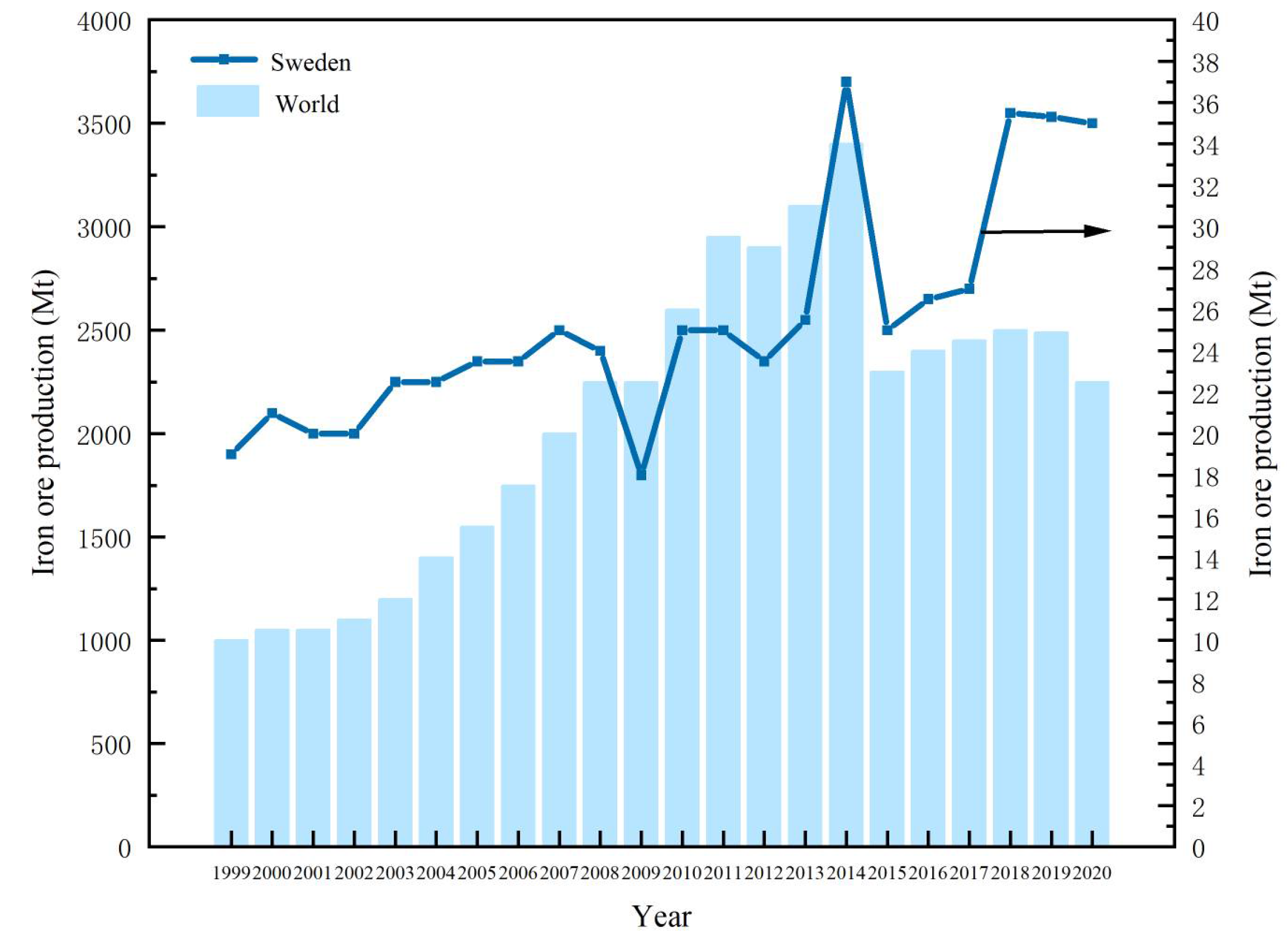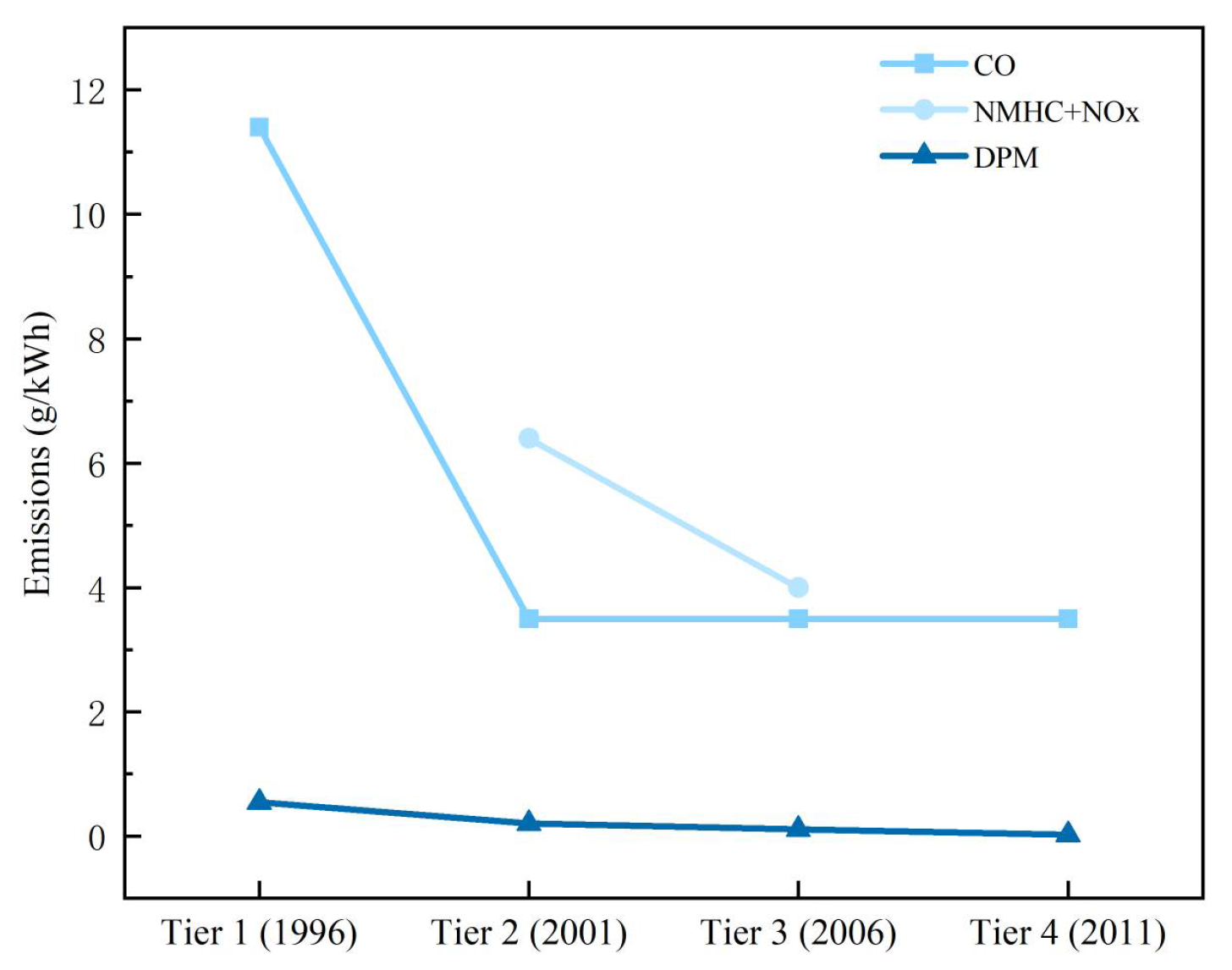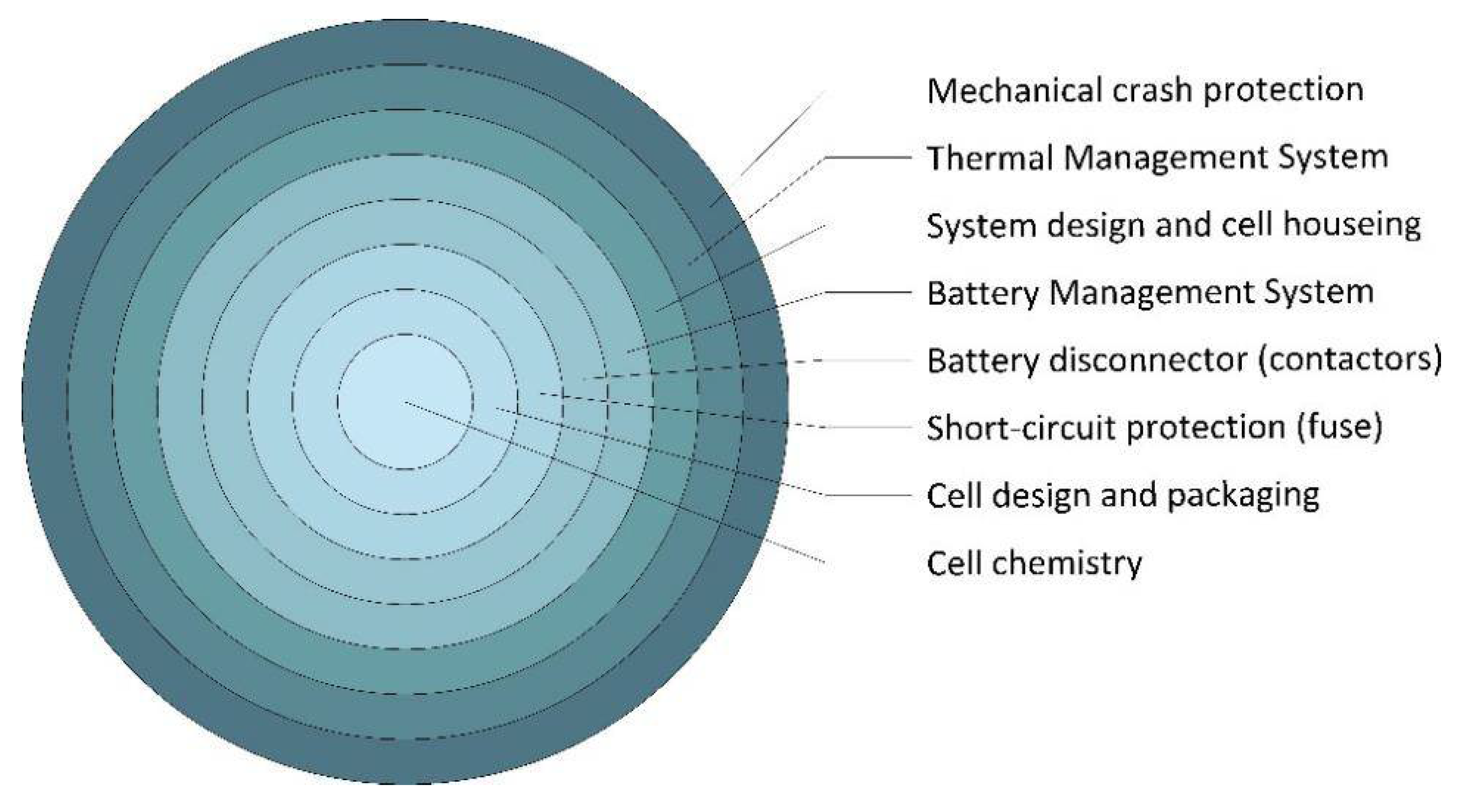Battery Electric Vehicles in Underground Mining: Benefits, Challenges, and Safety Considerations
Abstract
1. Introduction
2. Regulations on Diesel Vehicles
3. Battery Chemistries Used in BEVs
4. Benefits of Using BEVs in Underground Mines
5. Temperature Limitations of BEVs
6. Risks Associated with Introducing BEVs to Underground Mining
7. Costs Associated with Implementation of BEVs
8. Future Alternatives to BEVs
9. Conclusions
10. Future Research Areas for BEV Implementation in Underground Mining
Funding
Conflicts of Interest
Abbreviations
| BEV | Battery electric vehicle |
| DPM | Diesel particulate matter |
| GHG | Greenhouse gases |
| ICE | Internal combustion engine |
| LIB | Lithium-ion battery |
| LFP | Lithium–iron–phosphate (battery chemistry) |
| LKAB | Luossavaara-Kiirunavaara Aktiebolag |
| NMC | Nickel–manganese–cobalt (battery chemistry) |
| OEM | Original equipment manufacturer |
| PPE | Personal protective equipment |
| VOD | Ventilation on Demand |
References
- Martens, P.N.; Rattmann, L. Mining and society: No mining, no future. In Proceedings of the Seventeenth International Mining Congress and Exhibition of Turkey, Ankara, Turkey, 19–22 June 2001; pp. 215–220. [Google Scholar]
- Federal Ministry of Agriculture, Regions and Tourism. World Mining Data: Iron and Ferro-Alloy Metals, Non-Ferrous Metals, Precious Metals, Industrial Minerals, Mineral Fuels; Federal Ministry of Agriculture, Regions and Tourism: Vienna, Austria, 2020; Available online: https://www.world-mining-data.info/wmd/downloads/PDF/WMD2020.pdf (accessed on 12 May 2025).
- Government of Canada. Iron Ore Facts. 2020. Available online: https://natural-resources.canada.ca/minerals-mining/mining-data-statistics-analysis/minerals-metals-facts/iron-ore-facts. (accessed on 18 November 2020).
- World Steel Association. Steel Facts. 2020. Available online: https://www.worldsteel.org/about-steel/steel-facts.html (accessed on 18 November 2020).
- Löf, A.; Ericsson, M. Iron Ore 2015: Market Review and Forecast. Eng. Min. J. 2015, 216, 34–39. Available online: https://www.e-mj.com/features/iron-ore-2015-market-review-and-forecast/ (accessed on 12 May 2025).
- USG Survey. Iron Ore Statistics and Information. 2021. Available online: https://www.usgs.gov/centers/nmic/iron-ore-statistics-and-information (accessed on 18 December 2021).
- World Gold Council. The Gold Mining Industry: Reputation & Issues. 2013. Available online: https://globescan.com/wp-content/uploads/2017/07/GlobeScan_World_Gold_Council_2013_Report.pdf (accessed on 12 May 2025).
- Jamasmie, C. Miners Should Adopt ‘Next-Generation’ Values to Battle Reputation Crisis, Anglo American Boss Says, Mining.com. 2020. Available online: https://www.mining.com/miners-need-to-adopt-next-generation-values-to-battle-reputation-crisis-says-anglo-american-boss/ (accessed on 4 February 2020).
- SSAB. First with Fossil-Free Steel. 2020. Available online: https://www.ssab.com/en/company/sustainability/first-in-fossil-free-steel (accessed on 18 November 2020).
- Swedish Ministry of Enterprise, Energy and Communication. Sweden’s Minerals Strategy. 2013. Available online: https://government.se/contentassets/78bb6c6324bf43158d7c153ebf2a4611/swedens-minerals-strategy.-for-sustainable-use-of-swedens-mineral-resources-that-creates-growth-throughout-the-country-complete-version (accessed on 12 May 2025).
- LKAB. HYBRIT—Towards Fossil-Free Steel. 2020. Available online: https://www.lkab.com/en/about-lkab/technological-and-process-development/research-collaborations/hybrit--for-fossil-free-steel/ (accessed on 27 October 2020).
- HYBRIT. The World’s First Fossil-Free Steel Ready for Delivery. 2021. Available online: https://www.hybritdevelopment.se/en/the-worlds-first-fossil-free-steel-ready-for-delivery/ (accessed on 18 August 2020).
- Kurnia, J.C.; Sasmito, A.P.; Wong, W.Y.; Mujumdar, A.S. Prediction and innovative control strategies for oxygen and hazardous gases from diesel emission in underground mines. Sci. Total Environ. 2014, 481, 317–334. [Google Scholar] [CrossRef]
- Jääskeläinen, H.; Addy Majewski, W. Engine Technology Evolution: Heavy-Duty Diesels. 2014. Available online: https://dieselnet.com/tech/engine_heavy-duty.php (accessed on 12 May 2025).
- European Parliament, Council of the European Union. Directive 97/68/EC. Measures Against the Emission of Gaseous and Particulate Pollutants from Internal Combustion Engines to Be Installed in Non-Road Mobile Machinery. 1997. Available online: https://eur-lex.europa.eu/legal-content/EN/TXT/?uri=CELEX%3A31997L0068 (accessed on 12 May 2025).
- European Parliament, Council of the European Union. Directive 2004/26/EC. Measures Against the Emission of Gaseous and Particulate Pollutants from Internal Combustion Engines to Be Installed in Non-Road Mobile Machinery. 2004. Available online: https://eur-lex.europa.eu/legal-content/EN/TXT/?uri=celex%3A32004L0026 (accessed on 12 May 2025).
- European Parliament, Council of the European Union. Regulation 2016/1628. Requirements Relating to Gaseous and Particulate Pollutant Emission Limits and Type-Approval for Internal Combustion Engines for Non-Road Mobile Machinery, Amending Regulations (EU) No 1024/2012 and (EU) No 167/2013, and Amending and Repealing Directive 97/68/EC. Available online: https://eur-lex.europa.eu/eli/reg/2016/1628/oj (accessed on 12 May 2025).
- Environmental Protection Agency. 40 CFR Parts 9 and 89. Final Rule for Determination of Significance for Nonroad Sources and Emission Standards for New Nonroad Compression-Ignition Engine at or Above 37 Kilowatts. 1994. Available online: https://www.govinfo.gov/content/pkg/FR-1994-06-17/html/94-13956.htm (accessed on 12 May 2025).
- Environmental Protection Agency. 40 CFR Parts 9, 86, and 89. Control of Emissions of Air Pollution from Nonroad Diesel Engines. 1998. Available online: https://www.govinfo.gov/content/pkg/FR-1998-10-23/pdf/98-24836.pdf (accessed on 12 May 2025).
- Environmental Protection Agency. 40 CFR Parts 9, 69, et al. Control of Emissions of Air Pollution from Nonroad Diesel Engines and Fuel. 2004. Available online: https://www.govinfo.gov/content/pkg/FR-2004-06-29/pdf/04-11293.pdf (accessed on 12 May 2025).
- Gourley, E.; A Renewed Giant. Solid Ground. 2021. Available online: https://solidground.sandvik/a-renewed-giant/ (accessed on 2 November 2021).
- Global Mining Guidelines Group. GMG Recommended Practices for Battery Electric Vehicles in Underground Mining, 2nd ed.; Canada Mining Innovation Council: Toronto, ON, Canada, 2018; Available online: https://gmggroup.org/wp-content/uploads/2024/08/2022-06-23_Recommended-Practices-for-Battery-Electric-Vehicles-in-Underground-Mining.pdf (accessed on 25 November 2020).
- Gravelle, J. Battery-powered LHDs—McEwen Mining Innovation Series. 2017. Available online: https://magazine.cim.org/en/videos/mcewen-mining-innovation-series/battery-powered-lhds/ (accessed on 12 May 2025).
- Battery University. Lithium-ion Safety Concerns. 2016. Available online: https://batteryuniversity.com/article/lithium-ion-safety-concerns (accessed on 20 November 2020).
- Ding, Y.; Cano, Z.P.; Yu, A.; Lu, J.; Chen, Z.W. Automotive Li-Ion Batteries: Current Status and Future Perspectives. Electrochem. Energy Rev. 2019, 2, 1–28. [Google Scholar] [CrossRef]
- Boudreault, F.; Hedqvist, A. From one generation to the next—Learnings from zero emission mining. In Proceedings of the Electric Mine Virtual Conference 2020, Online, 4–6 August 2020. [Google Scholar]
- Ecolithiumbattery. LFP Vs NMC Battery: Complete Comparison Guide. 2025. Available online: https://www.ecolithiumbattery.com/lfp-vs-nmc-battery/ (accessed on 3 July 2025).
- Popp, H.; Attia, J.; Delcorso, F.; Trifonova, A. Lifetime analysis of four different lithium ion batteries for (plug-in) electric vehicle. In Proceedings of the Transport Research Arena (TRA) 5th Conference: Transport Solutions from Research to Deployment, Paris, France, 14–17 April 2014; Available online: https://www.researchgate.net/profile/HartmutPopp/publication/301788355_Lifetime_analysis_of_four_different_lithium_ion_batteries_for_plug_-_in_electric_vehicle/links/57285c5508ae586b21e2a769/Lifetime-analysis-of-fourdifferent-lithium-ion-batteries-for-plug-in-electric-vehicle.pdf (accessed on 12 May 2025).
- Frost & Sullivan. Emerging Innovations Enabling Cobalt-Free Batteries. 2020. Available online: https://store.frost.com/emerging-innovations-enabling-cobalt-free-batteries.html (accessed on 3 July 2025).
- Plasgård, V. Closing the loop with greener batteries in mining. In Proceedings of the Euro Mine Connect 2021, Online, 1–3 June 2021. [Google Scholar]
- Colthorpe, A.; Choice of Lithium Iron Phosphate not a ‘Silver Bullet Solution’ for Safety. Energy Storage News, 21 August 2020. Available online: https://www.energy-storage.news/news/lfp-vs-nmc-not-a-silver-bullet-solution-for-safety (accessed on 21 August 2020).
- Brand, M.; Gläser, S.; Geder, J.; Menacher, S.; Obpacher, S.; Jossen, A.; Quinger, D. Electrical safety of commercial Li-ion cells based on NMC and NCA technology compared to LFP technology. World Electr. Veh. J. 2013, 6, 572–580. [Google Scholar] [CrossRef]
- Buchal, C.; Karl, H.D.; Sinn, H.W. Kohlemotoren, Windmotoren und Dieselmotoren: Was zeigt die CO2-Bilanz? Ifo Schnelld. 2019, 72, 40–54. [Google Scholar]
- Hoekstra, A. The Underestimated Potential of Battery Electric Vehicles to Reduce Emissions. Joule 2019, 3, 1412–1414. [Google Scholar] [CrossRef]
- Lansstyrelsen Norrbotten. Climate and Energy Strategy for the County of Norrbotten 2020–2024. 2019. Available online: https://www.pitea.se/contentassets/1cf67ba47e3e4e659e19de5b53cfc1bd/norrbottens-klimat--och-energistrategi-2020-2024_ta.pdf?t=638837559374555963 (accessed on 12 May 2025).
- International Agency for Research on Cancer. IARC: Diesel Engine Exhaust Carcinogenic. 2012. Available online: https://www.iarc.who.int/wp-content/uploads/2018/07/pr213_E.pdf (accessed on 12 May 2025).
- Bugarski, A.D.; Janisko, S.J.; Cauda, E.G.; Noll, J.D.; Mischler, S.E.; Diesel Aerosols and Gases in Underground Mines: Guide to Exposure Assessment and Control. Department of Health and Human Services. 2011. Available online: https://www.cdc.gov/niosh/docs/mining/userfiles/works/pdfs/2012-101.pdf (accessed on 12 May 2025).
- Swedish Work Environment Authority. AFS 2018:1 Hygieniska Gränsvärden [Hygienic Limit Values]. 2018. Available online: https://www.av.se/globalassets/filer/publikationer/foreskrifter/hygieniska-gransvarden-afs-2018-1.pdf (accessed on 12 May 2025).
- Halim, A.; Kerai, M. Ventilation Requirement for ‘Electric’ Underground Hard Rock Mines—A Conceptual Study. In Proceedings of the Australian Mine Ventilation Conference 2013, Adelaide, SA, Australia, 1–3 July 2013; pp. 215–220. [Google Scholar]
- Gyamfi, S. Considerations and Development of a Ventilation on Demand System in Konsuln Mine. Master’s Thesis, Luleå University of Technology, Luleå, Sweden, 2020. [Google Scholar]
- Gaillard, S.; Sarver, E.; Gauda, E. A field study on the possible attachment of DPM and respirable dust in mining environments. J. Sustain. Min. 2019, 18, 100–108. [Google Scholar] [CrossRef] [PubMed]
- Maximilien, D.; Couture, C.; Njanga, P.E.; Neesham-Grenon, E.; Lachapelle, G.; Coulombe, H.; Halle, S.; Aubin, S. Diesel engine exhaust exposure in two underground mines. Int. J. Min. Sci. Technol. 2017, 27, 641–645. [Google Scholar]
- Peters, S.; de Klerk, N.; Reid, A.; Fritschi, L.; Musk, A.B.; Vermeulen, R. Estimation of quantitative levels of diesel exhaust exposure and the health impact in the contemporary Australian mining industry. Occup. Environ. Med. 2017, 74, 282–289. [Google Scholar] [CrossRef]
- Attfield, M.D.; Schleiff, P.L.; Lubin, J.H.; Blair, A.; Stewart, P.A.; Vermeulen, R.; Coble, J.B.; Silverman, D.T. The Diesel Exhaust in Miners Study: A Cohort Mortality Study with Emphasis on Lung Cancer. J. Natl. Cancer Inst. 2012, 104, 869–883. [Google Scholar] [CrossRef]
- Boffetta, P.; Dosemeci, M.; Gridley, G.; Bath, H.; Moradi, T.; Silverman, D. Occupational exposure to diesel engine emissions and risk of cancer in Swedish men and women. Cancer Causes Control 2001, 12, 365–374. [Google Scholar] [CrossRef] [PubMed]
- Silverman, D.T.; Samanic, C.M.; Lubin, J.H.; Blair, A.E.; Stewart, P.A.; Vermeulen, R.; Coble, J.B.; Rothman, N.; Schleiff, P.L.; Travis, W.D.; et al. The Diesel Exhaust in Miners study: A nested case-control study of lung cancer and diesel exhaust. J. Natl. Cancer Inst. 2012, 104, 855–868. [Google Scholar] [CrossRef]
- Steenland, K.; Deddes, J.; Stayner, L. Diesel exhaust and lung cancer in the trucking industry: Exposure–response analyses and risk assessment. Am. J. Ind. Med. 1998, 34, 220–228. [Google Scholar] [CrossRef]
- Rojas-Mendoza, L.; Sarver, E.A.; Saylor, J.R. Removal of DPM from an Air Stream Using Micron-Scale Droplets. Aerosol Air Qual. Res. 2017, 17, 1865–1874. [Google Scholar] [CrossRef]
- International Mining and Resources Conference. GMG Discussion: Battery Electric Vehicles Project Update. 2020. Available online: https://www.miningreview.com/event-listings-2/international-mining-and-resources-conference-2020/ (accessed on 10 June 2025).
- Gleeson, D. Kirkland Lake Gold’s Macassa Mine on the Charge with Battery-Electric Machines. International Mining, 16 January 2019. Available online: https://im-mining.com/2019/01/16/kirkland-lake-golds-macassa-mine-charge-battery-electric-machines/ (accessed on 12 May 2025).
- Vale. Vale SA 2020 Integrated Report. 2020. Available online: https://sustainabilityreports.com/reports/vale-sa-2020-integrated-report-pdf/ (accessed on 10 June 2021).
- Luo, H.; Wang, Y.; Feng, Y.H.; Fan, X.Y.; Han, X.; Wang, P.F. Lithium-Ion Batteries under Low-Temperature Environment: Challenges and Prospects. Materials 2022, 15, 8166. [Google Scholar] [CrossRef]
- Sturk, D.; Hoffmann, L.; Tidblad, A.A. Fire Tests on E-vehicle Battery Cells and Packs. Traffic Inj. Prev. 2015, 16 (Suppl. S1), 159–164. [Google Scholar] [CrossRef] [PubMed]
- Bisschop, R.; Willstrand, O.; Rosengren, M. Handling Lithium-Ion Batteries in Electric Vehicles: Preventing and Recovering from Hazardous Events. Fire Technol. 2020, 56, 2671–2694. [Google Scholar] [CrossRef]
- National Transportation Safety Board. Highway Accident Brief: Single-Vehicle Run-Off-Road Crash and Fire, Fort Lauderdale, Florida. 2018. Available online: https://www.ntsb.gov/investigations/AccidentReports/Reports/HAB1908.pdf (accessed on 8 May 2018).
- DNV-GL. Considerations for ESS Fire Safety. 2017. Available online: https://www.nyserda.ny.gov/-/media/Project/Nyserda/Files/Publications/Research/Energy-Storage/20170118-ConEd-NYSERDA-Battery-Testing-Report.pdf (accessed on 12 May 2025).
- Kutschenreuter, M.; Klüh, S.; Fast, L.; Lakkonen, M.; Rothe, R.; Leismann, F.; Fire Safety of Lithium-Ion Traction. RISE Research Institutes of Sweden. 2020. Available online: https://www.ri.se/sites/default/files/2020-12/Klueh2020_Fire_Safety_of_Lithium-Ion_Traction_Batteries_1.pdf (accessed on 12 May 2025).
- Willstrand, O.; Bisschop, R.; Rosengren, M.; Fire Suppression Tests for Vehicle Battery Pack. RISE Research Institutes of Sweden. 2019. Available online: https://www.researchgate.net/publication/337330881_Fire_Suppression_Tests_for_Vehicle_Battery_Pack (accessed on 10 June 2020).
- Federal Roads Office. Risk Minimisation of Electric Vehicle Fires in Underground Traffic Infrastructures. 2020. Available online: https://www.empa.ch/documents/56066/11711165/AGT_2018_006_EMob_RiskMin_Undergr_Infrastr_Final_Report_V1.0.pdf/b0dd84d7-5440-42e2-adf7-6e03095f7f8f (accessed on 12 May 2025).
- Willstrand, O.; Bisschop, R.; Blomqvist, P.; Temple, A.; Anderson, J.S. Toxic Gases from Electric Vehicle Fires. 2020. Available online: https://docslib.org/doc/9966792/toxic-gases-from-electric-vehicle-fires (accessed on 10 June 2020).
- Tokac, B.; Zhang, Q.; Sari, Y.A. Environmental and economic comparison of diesel and electric trucks in open-pit mining operations. J. Clean. Prod. 2025, 507, 145540. [Google Scholar] [CrossRef]
- Hooli, J.; Halim, A. Battery electric vehicles in underground mines: Insights from Industry. Renew. Sustain. Energy Rev. 2025, 208, 115024. [Google Scholar] [CrossRef]
- Acuña-Duhart, J.; Le, M.; Levesque, M.; Le, P. New Afton Mine diesel and battery electric load haul dump vehicles field test: Heat and dust contribution study. Maint. Eng. Reliab. 2024, 15, 158–171. [Google Scholar] [CrossRef]
- Akinrinlola, A. Replacing Combustion Engines with Hydrogen Fuel Cells to Power Mining Haul Trucks. Master’s Thesis, Missouri University of Science and Technology, Rolla, MO, USA, 2022. [Google Scholar]
- Gómez, J.R.; Alcaraz, J.M.G.; Fernández, J.F. Viability analysis of underground mining machinery using green hydrogen as a fuel. J. Clean. Prod. 2019, 241, 118–129. [Google Scholar]
- Miller, D. Fuel cell technology in underground mining. In Proceedings of the Platinum 2012 Conference, Sun City, South Africa, 17–21 September 2012; pp. 533–546. [Google Scholar]




Disclaimer/Publisher’s Note: The statements, opinions and data contained in all publications are solely those of the individual author(s) and contributor(s) and not of MDPI and/or the editor(s). MDPI and/or the editor(s) disclaim responsibility for any injury to people or property resulting from any ideas, methods, instructions or products referred to in the content. |
© 2025 by the authors. Licensee MDPI, Basel, Switzerland. This article is an open access article distributed under the terms and conditions of the Creative Commons Attribution (CC BY) license (https://creativecommons.org/licenses/by/4.0/).
Share and Cite
Kuslap, E.; Li, J.; Talehatibieke, A.; Hitch, M. Battery Electric Vehicles in Underground Mining: Benefits, Challenges, and Safety Considerations. Energies 2025, 18, 3588. https://doi.org/10.3390/en18143588
Kuslap E, Li J, Talehatibieke A, Hitch M. Battery Electric Vehicles in Underground Mining: Benefits, Challenges, and Safety Considerations. Energies. 2025; 18(14):3588. https://doi.org/10.3390/en18143588
Chicago/Turabian StyleKuslap, Epp, Jiajie Li, Aibaota Talehatibieke, and Michael Hitch. 2025. "Battery Electric Vehicles in Underground Mining: Benefits, Challenges, and Safety Considerations" Energies 18, no. 14: 3588. https://doi.org/10.3390/en18143588
APA StyleKuslap, E., Li, J., Talehatibieke, A., & Hitch, M. (2025). Battery Electric Vehicles in Underground Mining: Benefits, Challenges, and Safety Considerations. Energies, 18(14), 3588. https://doi.org/10.3390/en18143588







